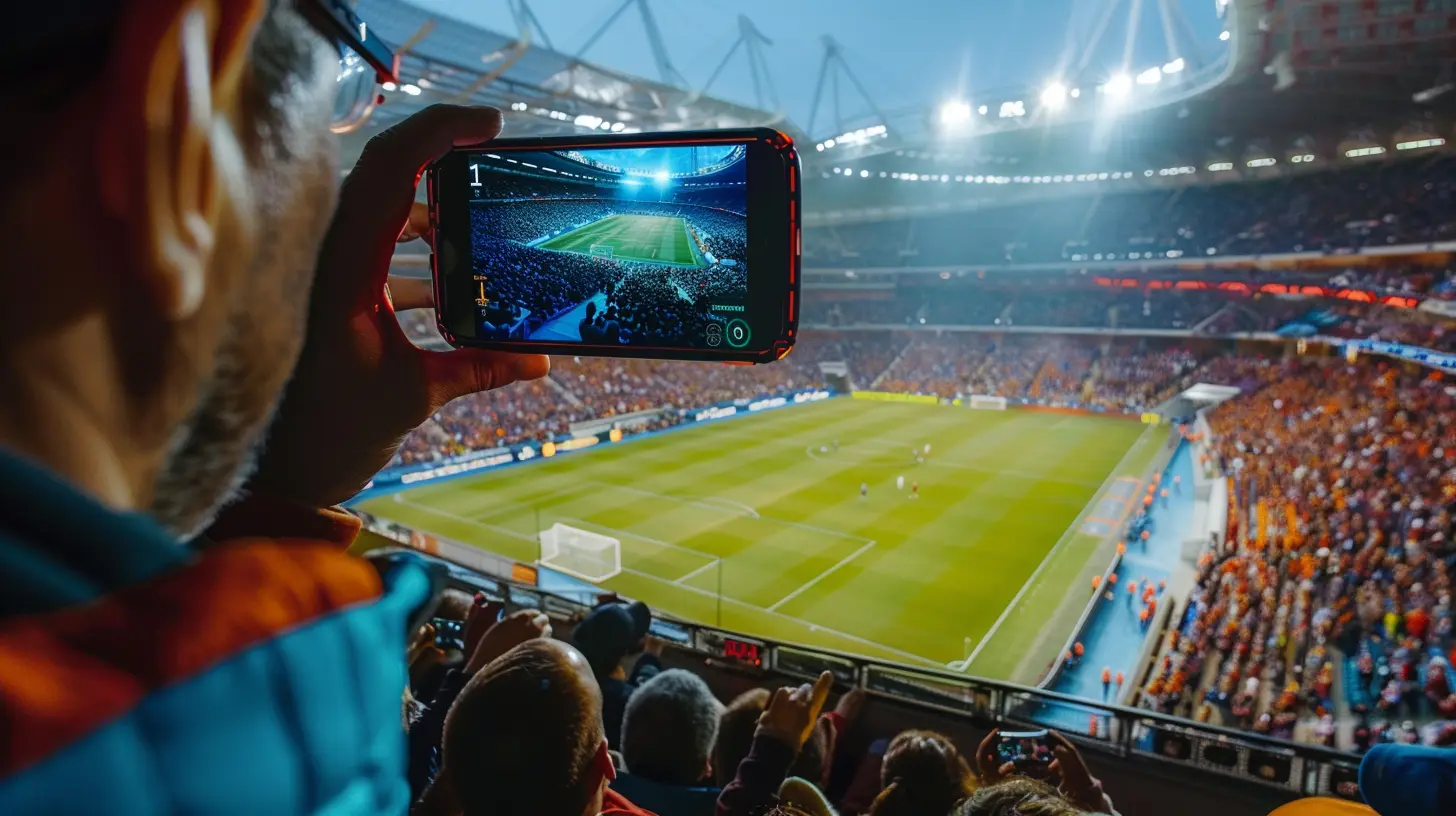How Stadiums Are Integrating Augmented Reality for Fans
3 June 2025
Gone are the days when watching a game meant simply sitting in the stands, cheering, and hoping for a good view of the action. With technology rapidly evolving, stadiums are now integrating augmented reality (AR) to create next-level experiences for fans. Imagine being able to see real-time player stats on your smartphone, overlay instant replays right in front of your eyes, or even navigate a massive stadium seamlessly—all thanks to AR.
But how exactly are stadiums using Augmented Reality to transform the game-day experience? Let’s dive in! 
The Rise of Augmented Reality in Sports
Augmented Reality has been making waves in various industries, from gaming to healthcare, and now it's taking over sports stadiums. This cutting-edge technology blends real-world environments with digital overlays, allowing fans to see extra layers of information in real time.With the rise of 5G internet, high-speed connectivity, and ultra-powerful smartphones, AR is becoming more accessible than ever. Sports franchises are now leveraging AR to enhance fan engagement, boost stadium revenue, and create unforgettable experiences.
So, how does this tech work in a stadium? Let’s break it down. 
How Stadiums Are Using Augmented Reality
1. Real-Time Player Stats & Insights
Ever wondered how fast a player is running or what their shooting accuracy is? With AR-powered mobile apps, fans can simply point their phones at the field and get real-time stats on players, including:- Speed
- Distance covered
- Shot accuracy
- Heart rate & fatigue levels
This provides an immersive experience similar to what broadcasters offer during live TV games—except now, it's right in the palm of your hand!
2. AR Instant Replays
Missed that stunning goal or dazzling slam dunk? No problem! Some stadiums are introducing AR-powered instant replays, where fans can relive key plays from different angles using their smartphones or AR glasses.It’s like having a personal replay system right in front of your eyes—no more waiting for the stadium screen to catch up!
3. Virtual Seat Previews
Buying tickets to a game? AR allows fans to preview their seat view before making a purchase. By using an AR-enabled app, users can:- See the exact view from their chosen seat
- Check sightlines and angles
- Avoid obstructed views
This transparency helps fans choose the best possible experience without any surprises on game day.
4. Augmented Wayfinding
Have you ever been lost inside a massive stadium, struggling to find your seat or the nearest food stall? AR-based navigation apps are solving this problem by offering:- Turn-by-turn directions to seats, restrooms, and concession stands
- Overlaid signage to help fans move around efficiently
- Real-time updates on queue wait times at food and drink counters
No more wandering aimlessly—just follow the arrows on your screen and get where you need to be!
5. Interactive Fan Engagement
Stadiums are also using AR to gamify the fan experience. Some innovative ways include:- AR scavenger hunts, where fans explore the stadium to unlock prizes
- Virtual meet-and-greets, where supporters can interact with digital avatars of players
- Live AR filters, allowing fans to take interactive selfies with team mascots or favorite athletes
This adds an extra layer of excitement, especially for younger fans who thrive on digital interactions!
6. AR Merchandise & Shopping
Imagine pointing your phone at a jersey in the stadium store and instantly seeing:- A 3D hologram of your favorite player wearing it
- Personalized size recommendations
- Exclusive behind-the-scenes content related to that item
This kind of interactive shopping not only boosts sales but also makes buying gear way more fun.
7. Holographic Replays & AR Glasses
While AR mobile apps are the most common way for fans to experience these features, some stadiums are experimenting with AR glasses to take it to the next level.Picture this: You’re watching a game through AR glasses, and every time there’s a critical play, you see holographic replays, instant player stats, or even advertisements tailored to your interests—all without looking away from the action.
Though AR glasses are still in their early stages, they could become the future of live sports experiences. 
The Benefits of Augmented Reality in Stadiums
1. Enhanced Fan Experience
AR brings extra entertainment and engagement, making attending a live game more interactive than ever. From real-time stats to replays, every moment is amped up.2. Increased Stadium Revenue
By integrating AR-powered shopping, merchandise sales skyrocket. Fans are also more likely to buy premium seats when they can visualize their views in advance.3. Better Navigation and Crowd Control
Nobody likes getting stuck in crowds or wandering around lost. AR wayfinding ensures fans move smoothly through the stadium, reducing congestion and improving safety.4. Stronger Fan Loyalty
The more immersive and exciting the experience, the more likely fans are to return. AR helps stadiums create unforgettable moments that keep supporters coming back.
Stadiums That Are Already Using Augmented Reality
Some of the biggest stadiums and sports franchises have already embraced AR technology. Here are a few leading the way:- SoFi Stadium (Los Angeles, USA) – One of the most tech-savvy stadiums in the world, using AR for enhanced fan experiences.
- Tottenham Hotspur Stadium (London, UK) – Implementing AR-powered wayfinding and seat previews.
- AT&T Stadium (Dallas, USA) – Experimenting with AR holographic replays.
- Mercedes-Benz Stadium (Atlanta, USA) – Offering AR merchandise previews and interactive fan engagement.
As more teams and stadiums invest in AR, it’s only a matter of time before this tech becomes the norm rather than the exception.
The Future of AR in Sports Stadiums
Augmented Reality still has a long way to go, but the potential is limitless. In the coming years, we might see:- AI-powered AR coaches, giving fans insights into in-game strategies
- Fully immersive AR glasses, replacing the need for smartphones
- Personalized advertising, displaying customized promotions based on fan preferences
- Virtual reality (VR) integration, allowing remote fans to feel like they’re inside the stadium
With advancements in 5G, AI, and AR hardware, the future of live sports is undoubtedly digital—and super immersive.
Final Thoughts
Stadiums are no longer just places to watch a game—they’re turning into high-tech entertainment hubs, redefining how we experience live sports. From real-time stats and holographic replays to AR-powered wayfinding and interactive fan engagement, the game-day experience is evolving like never before.So next time you step into a stadium, keep your eyes open—you might just witness the future of sports unfolding right before you!
all images in this post were generated using AI tools
Category:
StadiumsAuthor:

Umberto Flores
Discussion
rate this article
3 comments
Zadie Phelps
Augmented reality enhances fan experience in stadiums, offering interactive features like 3D replays and player stats that elevate game day excitement.
June 9, 2025 at 2:49 AM

Umberto Flores
Thank you! Augmented reality truly transforms the stadium experience by adding a dynamic layer of interactivity that keeps fans engaged and informed during the game.
Diana Romero
AR: The new MVP for fans!
June 7, 2025 at 10:44 AM

Umberto Flores
Absolutely! Augmented reality is transforming the fan experience, making every game more immersive and engaging.
Cruz Barker
Augmented reality in stadiums enhances fan experience; exciting innovation ahead!
June 6, 2025 at 12:36 PM

Umberto Flores
Thank you! We're thrilled about the potential of augmented reality to transform fan experiences in stadiums. Exciting times ahead!



